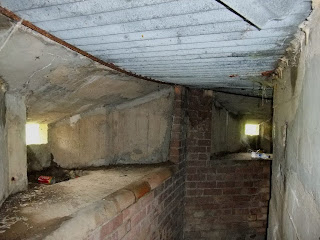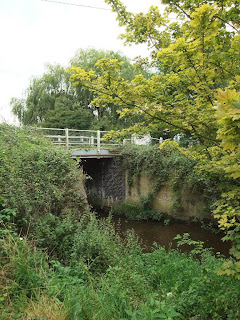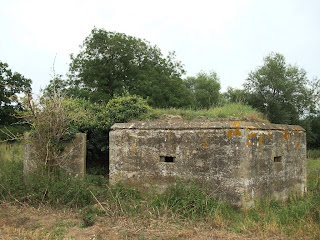Recently back from a trip up to Yorkshire visiting family (so expect some more posts from Yorkshire!). Anyway on the way up I stopped off just north of Bury St Edmund's to take a quick look at some pillboxes on the Eastern Command Line. Not really time for a detailed search but a quick recce of the ground for reference to a future visit. That saying, still some nice pillboxes seen. Here the anti-tank obstacle is the River Lark, which the Command Line followed from Bury St Edmond's until it met the GHQ Stop Line in Camridgeshire at the River Great Ouse. The pillboxes are all of the Eastern Command CRE design - 1094, 1113 and 1116. Note the Serial No reference referred to for the pillboxes etc is the reference given in the original Engineers plans for the Command Line.
Above: River Lark - the anti-tank obstacle
A couple of the pillboxes are of interest. One has metal rods fixed above the embrasure - for what purpose I don't know and it is the only pillbox I have seen this on so far.
Above: Pillbox to design CRE 1094, Serial No N28. Note metal rods above embrasure.
Another has some of the corrugated iron sheets used for the roof shuttering still in place. The condition of the sheets is quite remarkable. I also liked the touch of using rounded brick shuttering for the weapons-shelf of the embrasures - showing a nice touch to detail by whoever constructed the pillbox!
Above: Pillbox to design CRE 1113. Note corrugated iron sheet used for roof shuttering still in place and the rounded bricks used for the shuttering of the weapons-shelf. Serial No N26.
All key crossings over the Command Line were covered with anti-tank guns. The 6pdr anti-tank gun pillbox which covers Flempton Bridge is now almost buried in spoil with a boat perched on top!
Above: Crossing over Command Line Serial No 9 (Flempton Staunch) with 6 pdr pillbox Serial No NA5 (to design CRE 1116) now covered in spoil with a boat on top!! This pillbox covered the crossing.
The final pics below show some of the other pillboxes in the area I managed to get to.
Image 1-3: Pillbox to design CRE1113 but not the AA version. It has a blast wall (instead of a low level protected entrance) which appears to have been joined to one side of the pillbox. Serial No N33a.
Image 4&5: Pillbox to design CRE1113 agian not the AA version. Corrugated Iron sheets have clearly been used for the roof shuttering. Serial No N24.
Image 5&6: Pillbox to design CRE1113 - the AA version with a central AA well. Serial No N29. Last photo shows the River lark with pillbox in distance.















Comments
Post a Comment